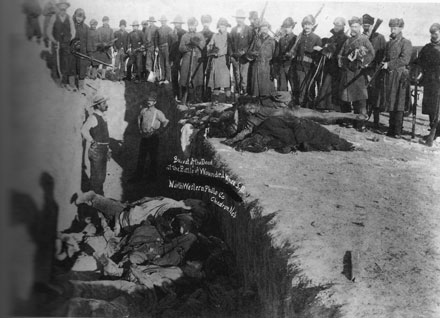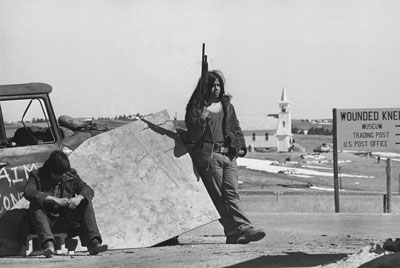From A World to Win News Service
Heartless at Wounded Knee
April 18, 2013 | Revolution Newspaper | revcom.us
April 8, 2013. A World to Win News Service. Millions of people have read the story of the violent conquest of American Indian lands in historian Dee Brown's 1971 classic Bury My Heart at Wounded Knee. But now the Oglala Lakota Sioux are being asked to buy what was stolen from them.
Today a parcel in Wounded Knee on the Pine Ridge reservation is owned by a non-Indian man who lives far away and wants to sell it. This part of the historic battleground is adjacent to the mass grave referred to in the book's title.

Victims of the 1890 massacre at Wounded Knee, where the U.S. Seventh Cavalry killed as many as 300 Lakota Indians, including children. Photo: Library of Congress
Wounded Knee, a village in South Dakota, is famous as the site where Native Americans inflicted a crushing defeat on a U.S. Army regiment in 1876, and where in 1890 the same Seventh Calvary regiment mowed down as many as 300 Indian men, women and children. It is also well-known because of the 1973 occupation of the village led by members of the American Indian Movement seeking justice.
This is a place whose value lies in its embodiment of Native American history. If the tribe wants to buy it, they will have to pay the owner almost four million dollars for 17 hectares [42 acres]. Otherwise, the owner says, he will auction it off to the highest bidder, hoping for commercial development. This situation is grotesque and criminal—more like demanding ransom money for ancestral bones than an ordinary commercial transaction—but is a perfectly legal consequence of a century and a half of legalized theft, murder and punishment of the survivors.
The U.S. government promised the Sioux an enormous extent of land in the north-central U.S. in the Fort Laramie Treaty of 1851. The government broke that treaty, and signed a new one for a much smaller amount of land in 1868. But three years later it passed the Indian Appropriation Act, which effectively turned reservations into prisoner of war camps whose inhabitants had no rights and could not leave. When gold and other valuable resources were discovered in the Black Hills, the government divided up the land, among Native Americans who hated the concept of private ownership of land and white settlers to whom private property was everything. Native Americans were left with land nobody else wanted—and then expelled from it when someone did.
In 1980 the Sioux were offered money from the federal government following a court decision that declared that their land had been taken from them illegally, in violation of the second Fort Laramie treaty. But accepting that settlement would mean giving up their claim to the Black Hills and they rejected it. Now the Oglala tribe of the Sioux is supposed to receive about 20 million dollars in compensation for government theft of money from land sales, but with the tribal government 60 million dollars in debt, this will not mark a turn for the better.
Much of the Pine Ridge Reservation is in Shannon County, the poorest county in the U.S. The land suitable for agriculture has been leased off to big producers. The tribal government is almost the only source of employment. About half the people live way below the official poverty line. The weather is harsh, the houses are in very bad condition, often unheated, and 40 percent have no electricity. Disease is rampant. Life expectancy is 47 years old for men and 52 for women, with drugs, alcohol, suicide and other forms of violence taking their toll. Rape is common, often carried out with impunity. Tribal governments have no authority over non-Indians who commit crimes on the reservation, and are most interested in enforcing their own rule. In reality they are local stooges of a federal government that is, at best, indifferent towards Native American lives.
Along with the kidnapping of Africans into slavery, the foundation of the wealth of the class that rules the U.S. today began with the seizure of Native American land and killing off the original inhabitants. Of the eight million Native Americans who once lived in what is now the U.S., according to an estimate, only a few hundred thousand were left by the beginning of the twentieth century, and they number only about half a million now. About half live in the country's 300 reservations.
The mark of a successful genocide is being able to say the victims themselves are responsible for killing themselves and each other on the reservations long after the cavalry imprisoned them there. Pine Ridge is a ghetto on the prairie, and when tribal members leave, it is usually for urban ghettos, the Army—or prison.
The 1890 Massacre
In 1890 the Native Americans from several tribes who were killed at Wounded Knee had been faced with a government order to sell their land. A chief named Sitting Bull and his followers refused. They were involved in the Ghost Dance movement, a religious revival that predicted the coming of a messiah and the end of white domination. The federal government considered it a sign of rebellion and moved to wipe it out by force. Sitting Bull was arrested and killed. The government ordered the arrest of the Sioux leader Big Foot and the tribe was declared "hostile," which amounted to a declaration of war.
The cavalry pursuing Big Foot's band was equipped with Hotchkiss guns, a new kind of rapid-firing weapon that shot explosive shells. It was a rotating cannon, lighter than standard artillery, designed to be pulled by horses through rough terrain. It was used in this last major battle between the U.S. Army and Native Americans, and then a short time later in the American conquest of Cuba and the Philippines.
Troops approached the group led by Big Foot and told him they were going to take the 120 men and 230 women and children to an army camp. Night was falling and the head army officer announced that their captives would be disarmed after daybreak. Teepees were set up. In the morning, not satisfied with the arms that had been turned over to them, soldiers began tearing apart the tents and belongings. A shot rang out as the troops scuffled with a warrior for his gun. The soldiers began firing indiscriminately.
"In the first few seconds of violence, the firing of carbines was deafening, filling the air with powder smoke. Among the dying who lay sprawled on the frozen ground was Big Foot. Then there was a brief lull in the rattle of arms, with small groups of Indians and soldiers grappling at close range, using knives, clubs and pistols. As few of the Indians had arms, they soon had to flee, and then the big Hotchkiss guns on the hill opened up on them, firing almost a shell a second, shredding the teepees with flying shrapnel, killing men, women and children.
"'We tried to run,' Louise Wise Bear said, 'but they shot at us like we were a buffalo. I know there are some good white people, but the soldiers must be mean to shoot children and women. Indian soldiers would not do that to white children...'
"The soldiers lost 25 dead and 39 wounded, most of them struck by their own bullets or shrapnel... A detail of soldiers went over the Wounded Knee battlefield, gathering up Indians still alive and loading them in wagons. As it was apparent by the end of the day that a blizzard was approaching, the dead Indians were left where they had fallen." (Bury My Heart at Wounded Knee)
Twenty soldiers were awarded medals of honour, the U.S.'s highest military distinction, for their work that day in 1890, the most ever awarded for a single battle in American history before or since. Those medals have not been rescinded, despite demands. In 1973 the government displayed the same attitude in its merciless persecution of people in Wounded Knee who rose up against a corrupt, puppet tribal government.
FBI Persecution, 1973

In the spring of 1973, hundreds of Indian people and their supporters went to Wounded Knee on the Pine Ridge reservation in South Dakota to demand an end to murderous attacks by police and government agents, and that the U.S. government honor its treaties granting Native people land and self-government. They found themselves surrounded by over 300 agents of the FBI, the Bureau of Indian Affairs (BIA), U.S. Marshals, and Justice Department and various local and state police. The Indians refused to back down—they defended themselves and held off the government forces for 71 days of siege. Photo: American Indian Movement (AIM) members at a roadblock to keep out government forces from Wounded Knee. Photo: AP
This time it was the FBI, not the cavalry, that was sent in, and in the context of those days—including support for the occupation from all over the U.S. and the world—they could not just use their big guns. But after the end of the 71-day armed stand-off they started a reign of terror on the reservation. About 1,200 people were arrested. At least two AIM members were killed and another activist disappeared.
Leonard Peltier was arrested for allegedly shooting two FBI agents during this warlike period. He always denied it, and the informant whose testimony helped lead to his conviction later said the FBI coerced her into lying. Other evidence has also been thrown into doubt by legal officials. He has had much support among ordinary people and prominent public figures. Nevertheless, Peltier has been in prison for the last 37 years, beaten badly on at least one recent occasion, with no prospect of release. Clearly this is about more than him; it is meant to send a message.
The cavalry has moved on to invade other countries, but the prison camps they constructed for Native Americans remain standing and under guard.
A World to Win News Service is put out by A World to Win magazine, a political and theoretical review inspired by the formation of the Revolutionary Internationalist Movement, the embryonic center of the world's Marxist-Leninist-Maoist parties and organizations.
If you like this article, subscribe, donate to and sustain Revolution newspaper.
